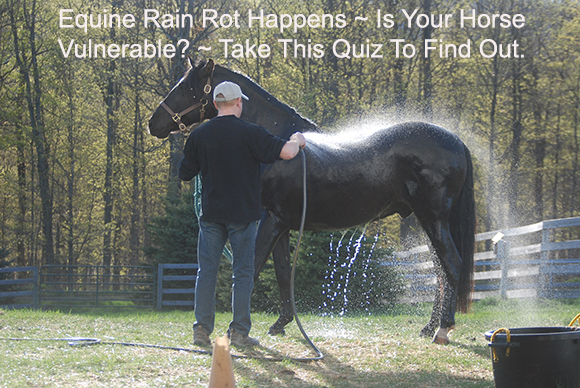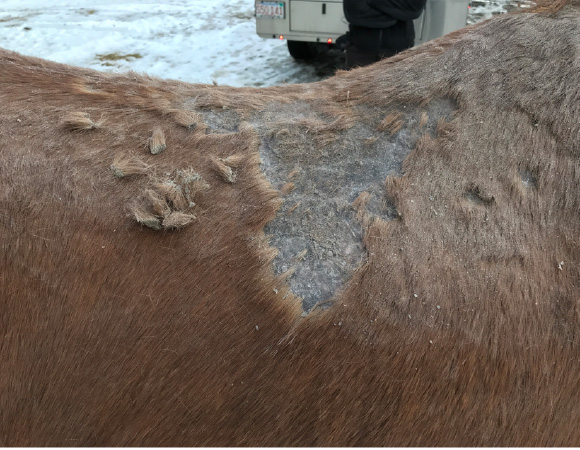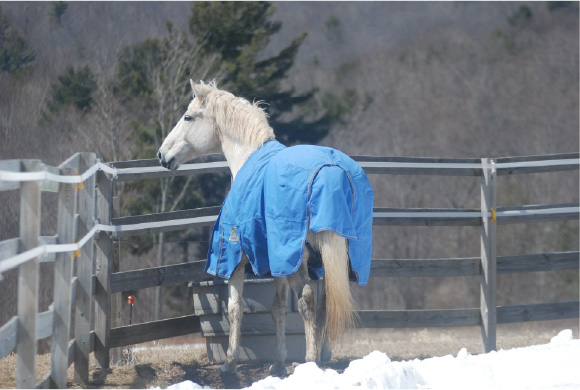Equine Rain Rot Happens ~ Is Your Horse Vulnerable?
~ Take This Quiz To Find Out.

You might be surprised to learn that rain rot is not an equine skin condition that occurs only due to neglect or poor care of the horse. Even the most diligent horse owner who provides the best care can have a horse experience rain rot.
What does rain rot look like?
If your horse develops crusty scabs that peel off with clumps of hair and leave bare spots on the skin then he has probably contracted rain rot. This condition is aptly named as it is caused by rain or moisture on the horse’s coat and is fairly common. It is also sometimes called rain scald.
It is most prevalent in regions of the country where there is high humidity, heavy rainfall and warm temperatures with an abundance of insects to complicate the condition.
The culprit that produces the bald skin and unsightly crusty scabs is the bacterium Dermatophilus congolensis.
Take this short quiz and test your knowledge of this common condition and learn your treatment options for rain rot:
True of False?
Q: Rain rot only affects horses that are left out in the rain for excessive periods without a blanket or run-in shed for protection?
False:
While it is true that rain rot is a common condition in horses whose skin is exposed to rain, horses can suffer rain rot when blanketed too.
As a caring horse owner you may diligently wash your blankets each season and re-proof them to maintain their waterproofing. If you use the wrong product to re-proof them you may block the air movement or wicking action the fabric previously exhibited, that allowed a horse’s sweat or body warmth to evaporate. This can set your horse up for a rain rot condition beneath his blanket.
Always check with the blanket manufacturer for advice on which products to use to re-proof blankets.
Rain rot can also occur when a horse owner uses a rain sheet or older blanketing product that does not have any breathability inherent in its fabric.
Horses are notoriously oblivious to the benefits of a run-in shed during wet or snowy weather. The run-in shed may provide a safe haven from punishing heat and shade from the sun’s rays, but the rest of the time a horse may simply ignore the benefit of the run-in shed. So provision of shelter will not automatically negate your horse from contracting rain rot.
Q: Rain rot can be resolved by peeling off the scabs that form. Followed by giving the horse a rigorous grooming.
False:
Rain rot is a bacterial condition and the skin should be treated to avoid spread of the spores.
The healthy horse has a natural skin barrier that will block penetration of the bacterium through the skin, however this may be mitigated by insect bites, wounds or sores or excessive moisture on the skin that removes the natural protective oils that would usually form a protective barrier.
Rain rot will invade the skin layers and small, pus-filled bumps or pustules will develop. These bumps can be felt underneath your hand when you feel the horse’s skin. They are a result of the accumulation of white cells and proteins that the horse’s immune system produce to counteract the rain rot bacteria.
As the pustules mature the skin layer below will die off and leave a clump of dead skin cells stuck to individual hairs. These clumps can be easily pulled off and the skin beneath will be raw and red.
If the causative factor such as humidity is removed, the hair will grow back in 7-10 days. But as the horse will be itchy during this time and his skin prone to invasion by insect bites or scrapes/wounds as the bare skin is unprotected by hair, the horse is vulnerable to secondary infection which is a much more serious condition.

Q: The best treatment is to apply a disinfecting spray to the horse’s coat.
True:
There are many products on the market that can aid in cleansing the horse’s coat. Often best applied to the underside of the horse’s hairs, by gently brushing the hairs backwards before a good dousing with the disinfecting spray, this will help the lesions quickly heal and further spread of pustules be prevented. Apply daily for several days to the affected areas.
In severe cases of rain rot it might be necessary to bath the horse with a medicated shampoo.
Q: Rain rot is similar to dew poisoning.
True:
The difference between rain rot and dew poisoning is mainly one of location. Dew poisoning is generally located on the pastern of the horse, while rain rot affects the neck, back and top of the head. Dermatophilus congolensis is the causative agent of both conditions.
Q: Rain rot can develop into a more serious condition if left untreated.
True:
If the causative agent of rain rot in the horse’s environment is removed, the rain rot scabs will slowly disappear. However, the red, raw and itchy skin left behind, makes the horse prone to secondary infection with Staphylococcal folliculitis, a much more serious skin condition. In extreme cases your horse may exhibit pain, fever, and loss of appetite. It is important secondary infection, is immediately treated by a veterinarian.
It is therefore prudent to take good horse care measures and address the rain rot will a topical application, to halt the spread of the bacteria and help prevent further distress to the horse’s skin. You do not need to remove the scabs as the anti-bacterial spray will loosen the scabs and they will drop off.
If your horse is suffering from severe itching you can also use a fungicide. While this is fungicide suitable for other conditions such as ringworm, it has also been effective at cleaning the hair while also providing a soothing treatment against itching with its incorporated lanolin formula.
Q: Rain rot is more prevalent in certain parts of the country and in certain weather conditions.
True:
For example, the southern United States temperatures provide a perfect climate for rain rot to affect the horse’s skin. Diligent management of the horse’s environment due to changes in temperature and weather is essential in prevention of the condition.
It is wise to review your blanket practices and clip long winter coats on horses moved from a cooler climate to a more humid location.
In conclusion, the cornerstone of good horse management is prompt action to resolve any horse health issue. The resolution of equine rain rot is relatively easy and can be quickly eradicated with the proper care. Here are the simple steps you can take to treat and successfully remove the unsightly and itchy rain rot for your horse.
1. Remove the causative factor of moisture from the horse’s environment to prevent further rain rot development on your horse’s skin.
2. Apply treatment such as a wound and skin care spray to the horse’s hair spraying against the direction of the hair growth i.e. the underside of the hair with liberal applications daily for several days.
3. For excessive itching associated with the rain rot condition apply a soothing agent such as a fungicide to provide both a topical cleanse hopefully with a lanolin formula barrier to soothe the skin.
4. In extreme cases of rain rot bathe your horse with a medicated shampoo prior to treatment.
5. In excessive cases where secondary infection may have already occurred consult your veterinarian for appropriate care.



